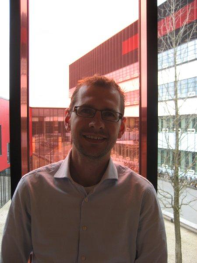Spectroscopy and transport on europium based ferromagnetic insulators
Promotion date: 10. May 2012
Promotor: Prof. dr. ir. Alexander Brinkman
Co-promotor: Prof. dr. ir. Hans Hilgenkamp
| Europium based ferromagnetic insulators are candidates for spintronic applications. In situ x-ray photoelectron spectroscopy is used to determine the stoichiometry of the europium oxide thin films. Based upon these measurements a growth parameter window is determined under which stoichiometric EuO is formed. The magnetic properties measured, using a vibrating sample magnetometer, of the EuO films confirm the stoichiometry as determined spectroscopically. It is shown that pulsed laser deposition can be used as a technique to grow EuO thin films. Also, the challenges of growing EuO on complex oxides are studied, and the feasibility of the formation of a dimensional electron gas on such an interface is investigated. The in situ core level x-ray photoelectron spectrum of EuO is discussed. Also briefly discussed is: the implementation of EuS ferromagnetic insulating double barrier junctions for spin filter experiments. |
Can you mention an important result of your thesis project?
Spintronic devices are used commercially already. For example in current hard disk drives. Europium monoxide (EuO) is chemically not a stable compound. Using pulsed laser deposition - a new deposition technique when it comes to growing EuO - I was able to deposit EuO thin films. An advantage of pulsed laser deposition is the relative easy integration of EuO with complex oxide materials.
A similar material system, EuS, is used in the growth of spin filter tunnel junctions. EuS is chosen for its better stability.
At the Massachusetts Institute of Technology in Boston, I was able to actually construct some devices. I succeeded in showing nice results there, measuring the spin polarization of those junctions.
My research was of a fundamental nature, showing convincingly EuS has application potential.
In what way did you develop personally as a researcher during this research project?
I learned to use different kinds of depositing and measurement techniques at Mesa+. Also I benefited from visits abroad, for example Boston. Herethey are used to performing spin polarization measurements for over thirty years now. I learned a great deal from the scientists working there. A guest from Barcelona vistited Twente to grow EuO thin films using pulsed laser deposition.
Apart from that, I enjoyed teaching and coaching students here in Twente, developing personally as an independent researcher realizing his own ideas and finding.
What are your future plans?
As an engineer coming from a regular higher educational background, I would very much love to develop my skills further in industry now. At the moment I prefer staying in Twente. Luckily some exciting companies could be interested here: Thales and Pananalytical for example as bigger companies. Spinoff companies from the University of Twente are also looking for new talent, like Solmates or Micronit Microfluidics.
Since my PhD was quite fundamental in nature, I would like to work on devices now: like I did in the last stages of my thesis project in an exploring fashion.
What, in your opinion, is important for Mesa+ to stay successful in future?
All the equipment and apparatus one could dream of, is available at Mesa+. For example, I was able to use the Comat System for depositions, ultra high vacuum techniques and a broad range of analytical instruments. It is all there for PhD’s and students. That is a great advantage that should be utilized and cherished, I believe.
As a team member at Mesa+ I experienced an atmosphere that is both supportive and challenging.
Perhaps in public relations more attention could be given towards the general public, showing what great achievements are performed here, to local and national press communities.

